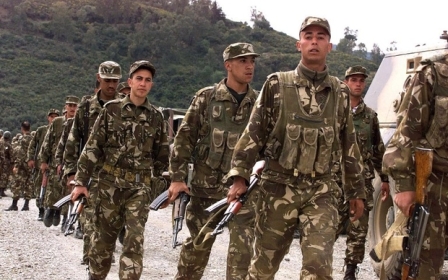IS made its first Farsi video: What it tells us about the group's goals in Iran

In a recently released video, the Islamic State (IS) group directly addresses Iran’s rulers and the country’s Sunni minority for the first time. The 36-minute video, showcasing native Iranians, has touched off a flurry of speculation about the importance of its timing and its real intended message.
In view of Iran’s significant contribution since 2014 to anti-IS military operations in Iraq, and to a much lesser extent in Syria, the video is clearly not primarily intended to deter the Islamic Republic from assisting regional countries to combat the jihadist group.
The misrepresentation of Iran as a secret ally of America and Israel merges seamlessly with a broader Arab nationalist discourse which seeks to present Iran as the 'other'
Instead, in keeping with its Salafi-Jihadist ethos, IS aspires to incite religious strife in Shia-majority Iran. By appealing directly to the country’s eight to 10 million-strong Sunni minority, IS hopes to influence reaction to local grievances and frame the overall narrative in a distinctly sectarian tone.
More broadly, the timing of the video is significant, not as a result of any Iran-specific reasons, but rather because it underlines the point that, despite losing territory in its Iraqi and Levantine heartlands, IS is more determined than ever to sow chaos and conflict across the Middle East and West Asia.
Iran as the Salafi 'other'
Entitled “The land of Persia: between yesterday and today”, the IS video draws on a sweeping historical meta-narrative to create a cogent religious and political dichotomy, effectively portraying the Iranian state, if not the Iranian nation, as the perennial enemy of Muslims.
There is nothing original about this rhetoric. It is entirely in keeping with Salafi-jihadi historical world view that draws a cultural and ideological equivalence between Iran’s pre-Islamic past and its contemporary Shia identity.
The so-called “Sassanid-Safavid” heritage is often cited by Salafi-Jihadis – indeed by Salafis of all stripes – to not only present the millennial Iranian state as perennially imperial, but also - and more importantly - to exclude the bulk of Iranian civilisation from the Islamic fold.
The Farsi used in the video is of poor quality replete with syntax, grammatical and even pronunciation errors
Beyond Salafi-jihadi ideology, there are hints of the rhetoric of the old Iraqi Baath party in the video, especially the repeated reference to the “Magus” (a derogatory term for Iran’s old religion Zoroastrianism), and the characterisation of Iran’s Sunni minority as a geographic and socio-economic outlier oppressed by a Persian-speaking Shia majority. This rhetoric was unsuccessfully deployed during the Iran-Iraq War to incite division in Iran.
Moreover, the misrepresentation of Iran as a secret ally of America and Israel merges seamlessly with a broader Arab nationalist discourse which seeks to present Iran as the “other” and a chameleon-like power set on sabotaging Islamic civilisation from within.
This historical meta-narrative is, of course, false on many levels. But IS commits a particularly glaring propagandistic faux pas by portraying the Safavids (the early 16th century conquerors of Iran) as champions of the Persian language and culture.
In fact, the Safavids were a Turkic dynasty whose many successes included entrenching Turkic speakers into the heart of Iranian statecraft. The effect of this legacy continues to the present day as Iran’s current leader, Ayatollah Seyed Ali Khamenei, is a Turkic speaker.
Factual errors are compounded by poor production more generally. While IS is renowned for its sleek propaganda videos, this one stands out for its inferior quality. Foremost, the Farsi used in the video is of poor quality replete with syntax, grammatical and even pronunciation errors.
While the video showcases four native Iranian men, none of them appear to be native Farsi speakers. One of the men speaks in Baluchi; one is an Arabic speaker from the south-western Khuzestan province; a masked fighter who appears at the end speaks Farsi with a distinctly Kurdish accent; while the main speaker and narrator is also possibly an Arab from Khuzestan province. However, it is equally possible that he may be from Iran’s south-eastern Sistan va Baluchistan province.
Hollow threats?
The terrorist content of the video can be analysed at two levels. First, IS makes a direct threat against Iranian leaders and the Iranian state. Second, the group incites Iranian Sunnis to armed revolt against the state with a view to restoring Sunni Islam as the ruling religion in the country.
IS operatives will be squaring up against intelligence services with a proven track record of detecting and disrupting plots at source
The terrorist threat to the state, in particular, to Iranian leaders and security forces, is lent a professional angle in the video, with IS presenting its so-called “Salman-e-Farsi” battalion. Toward the end of the video, 16 masked fighters are shown practising at a makeshift shooting range with portraits of Iranian leaders and military commanders (notably Quds force commander Major General Qassem Soleimani) used as target practice.
The name of this battalion is important as it seeks to lend IS’s Iranian military chapter a measure of historical and national legitimacy. Salman-e-Farsi was a companion of the Prophet Muhammad and the first Iranian convert to Islam. Both Iranian Shias and Sunnis regard him as a national religious icon.
IS is not the first Salafi-jihadi outfit to threaten terrorist attacks inside Iran. In June 2015, Abu Muhammad al-Jolani, the leader of the then Nusra Front (the former al-Qaeda affiliate in Syria), appeared to threaten attacks inside Iran by way of retaliation for Iran’s decisive intervention in the Syrian conflict.
Formidable challenge
As of today, no terrorist attack has materialised. This speaks to the operational challenges of attacking the Islamic Republic at home. Iranian intelligence and counter-terrorism forces are widely regarded as some of the best in the world, having gained vital experience and superior skills over more than three decades of sparring with a wide array of indigenous terrorist groups in addition to Western and Israeli intelligence services.
While there are credible reports of IS recruitment in the Iran-Iraq border areas, IS will face formidable operational challenges in conducting major terrorist attacks in the Iranian capital and other major cities. IS operatives will be squaring up against intelligence services with a proven track record of detecting and disrupting plots at source.
IS has inadvertently minimised the potential for recruitment by framing the war as not only against the Iranian state but also against the vast majority of the Iranian people
The second aspect of the threat, namely incitement of Iranian Sunnis to terrorism, is a more credible scenario. The threat is amplified by IS’s violent rejection of the representatives of the Iranian Sunni community, notably Molavi Abdul Hamid, who are portrayed as collaborators of the “Rafidi” state.
The credibility of the threat is further accentuated and brought into sharp relief by IS’s increasing propensity to incite so-called lone wolf terror attacks in the capital cities of its adversaries.
But can such tactics really work in Iran’s forbidding counter-terrorism environment and in its highly idiosyncratic local governance and inter-religious milieu?
While some Iranian Sunni communities, particularly in the under-developed Sistan va Baluchistan province, have a range of legitimate grievances, IS will struggle to appeal to a critical mass of disaffected elements within these communities.
IS has inadvertently minimised the potential for recruitment by framing the war as not only against the Iranian state but also against the vast majority of the Iranian people who qualify as “Rafidis” by IS standards. This incitement to genocide is bound to unsettle even the most hardened and ruthless Iranian Salafis.
Finally, there is one area that this propaganda video successfully addresses. From an expansive strategic standpoint, IS is keen to link up its Levantine and Iraqi heartlands to its growing presence in South Asia, notably Pakistan and Afghanistan. Through its first Farsi language video, and by focussing on Iran, IS has taken the first tentative steps to meet this objective - at least at the rhetorical and propaganda levels.
- Mahan Abedin is an analyst of Iranian politics. He is the director of the research group Dysart Consulting.
The views expressed in this article belong to the author and do not necessarily reflect the editorial policy of Middle East Eye.
Photo: An image grab taken from a video released by Islamic State group's official Al-Raqqa site via YouTube on in September 2014 (AFP/IS)
This article is available in French on Middle East Eye French edition.
Middle East Eye propose une couverture et une analyse indépendantes et incomparables du Moyen-Orient, de l’Afrique du Nord et d’autres régions du monde. Pour en savoir plus sur la reprise de ce contenu et les frais qui s’appliquent, veuillez remplir ce formulaire [en anglais]. Pour en savoir plus sur MEE, cliquez ici [en anglais].





